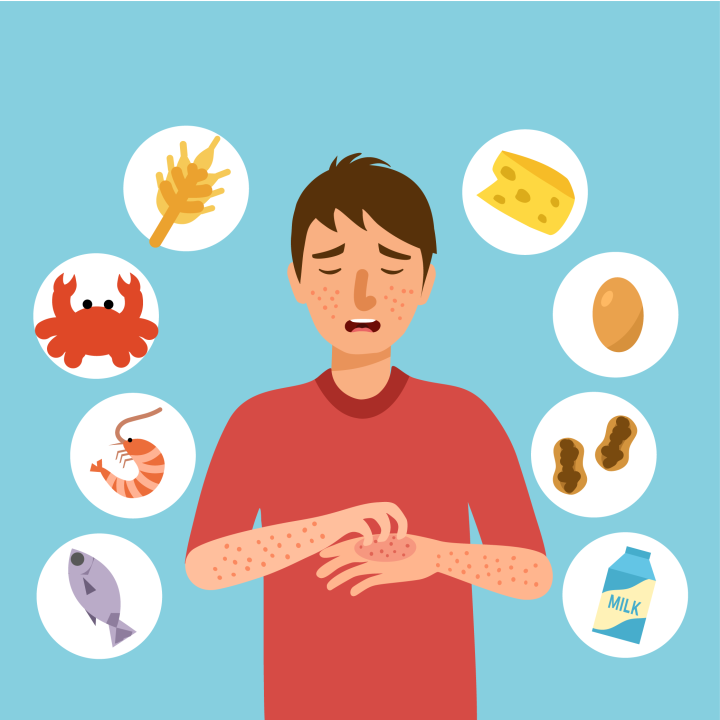
Allergies*
Allergies in children are common and can range from mild to severe. Allergies occur when the immune system reacts to a usually harmless substance, such as pollen, dust, or certain foods. Knowing how to identify, manage, and prevent allergy symptoms can help you keep your child safe and comfortable.
1. What Causes Allergies?
• Genetics: Allergies often run in families. If one or both parents have allergies, there’s an increased chance their child will have them too.
• Environmental Triggers: Common allergens include pollen, pet dander, dust mites, mold, and certain foods.
• Immune Response: In children with allergies, the immune system reacts to allergens as if they were harmful, releasing chemicals like histamines that cause symptoms.
2. Types of Allergies in Children
• Food Allergies: Common food allergens include peanuts, tree nuts, eggs, milk, wheat, soy, fish, and shellfish.
• Seasonal Allergies (Hay Fever): Often caused by pollen from trees, grasses, and weeds, especially in spring and fall.
• Indoor Allergies: Dust mites, mold, and pet dander can trigger year-round symptoms, especially indoors.
• Skin Allergies: Contact with irritants or allergens can cause reactions like eczema or hives.
• Insect Sting Allergies: Bee or wasp stings can cause allergic reactions ranging from mild to severe (anaphylaxis).
3. Symptoms of Allergies
• Respiratory Symptoms: Sneezing, runny or congested nose, itchy eyes, and coughing are common with seasonal and indoor allergies.
• Skin Reactions: Redness, itching, hives, and eczema can occur from food allergies, insect stings, or skin contact with allergens.
• Digestive Symptoms: Stomach pain, vomiting, and diarrhea often indicate food allergies.
• Anaphylaxis: A severe, life-threatening reaction that can cause difficulty breathing, swelling, hives, and a drop in blood pressure. Immediate medical attention is required.
4. Identifying Allergies
• Observe Patterns: Note when symptoms occur, what your child was doing, or what they ate to help identify triggers.
• Allergy Testing: Doctors may recommend skin prick tests, blood tests, or elimination diets to identify specific allergens.
• Family History: Share any family history of allergies with your doctor, as it may help pinpoint possible triggers.
5. Managing Allergy Symptoms
• Avoid Triggers: Identify and reduce exposure to known allergens. For example, use air purifiers for indoor allergies or avoid certain foods if your child has food allergies.
• Medications: Antihistamines can relieve mild allergy symptoms, while nasal sprays and eye drops can help with nasal and eye symptoms. Always consult your child’s doctor before giving any medication.
• Epinephrine for Severe Allergies: Children with a risk of anaphylaxis should carry an epinephrine auto-injector (e.g., EpiPen) and know how to use it in case of a severe reaction.
6. Preventive Measures
• For Seasonal Allergies:
• Limit outdoor activities during high pollen counts and keep windows closed.
• Shower and change clothes after outdoor play to remove pollen.
• Use HEPA filters in the home to reduce indoor allergens.
• For Food Allergies:
• Read food labels carefully to avoid allergens.
• Inform teachers, caregivers, and friends’ parents about your child’s food allergies.
• Consider having an action plan in case of accidental exposure.
• For Indoor Allergies:
• Dust and vacuum regularly, wash bedding in hot water, and consider using dust mite covers on mattresses and pillows.
• Reduce exposure to pets if your child is allergic to pet dander.
• Manage humidity to prevent mold growth.
7. When to See a Doctor
• Severe Reactions: If your child shows signs of anaphylaxis (e.g., difficulty breathing, swelling, or dizziness), seek emergency care immediately.
• Frequent Symptoms: If allergy symptoms persist or interfere with daily life, consult an allergist for testing and a management plan.
• Eczema or Skin Rashes: For persistent skin reactions, a dermatologist or allergist can help with specialized treatments.
8. Emotional Support for Your Child
• Help Them Understand: Teach your child about their allergies, what to avoid, and how to recognize symptoms.
• Encourage Self-Advocacy: As they get older, teach your child to speak up about their allergies and ask questions, especially in social settings.
• Support Their Social Life: Work with teachers, coaches, and other parents to create safe environments so your child can participate confidently in activities.
Managing allergies requires a proactive approach, from identifying allergens to taking steps to prevent symptoms and having an action plan in place for emergencies. With the right care, children with allergies can lead healthy, active lives.
Leave a comment
Comments will be approved before showing up.



